Executive Summary
This case study highlights the successful implementation of the KMC AFMS (Airflow Measurement System) by ChampionAC in collaboration with KMC Controls at a climate-controlled storage facility for medical-grade materials. The end user, a supply chain management provider, sought a sustainable solution to maintain proper room pressurization and ventilation levels in compliance with OSHA regulations. Traditional AMD (airflow measurement device) technology was deemed unreliable due to duct system geometry constraints and cost implications. By leveraging KMC Controls’ expertise and the innovative AFMS, the end user achieved accurate, reliable measurement of OA (outside air) and EA (exhaust air) flow rates while addressing their specific challenges. Furthermore, the implementation resulted in additional short- and long-term benefits.
Introduction
The purpose of this case study is to demonstrate the successful resolution of the end user’s pressurization and ventilation challenges through the implementation of the KMC AFMS. This report provides valuable insights into the process, solutions, and outcomes of the project, which can guide system integrators and facility managers facing similar issues.
Customer Profile
Market Channel: Industrial Facility—Environmentally Controlled Warehouse
End User: A multinational package delivery, supply-chain management, and logistics consulting company
Partner: ChampionAC
Site Details: The project involved new AAON® AHUs at a site dedicated to the transfer and storage of medical-grade materials. Each AHU featured a heat wheel with bypass damper, relief dampers, and an independently operated exhaust fan.
The Challenge
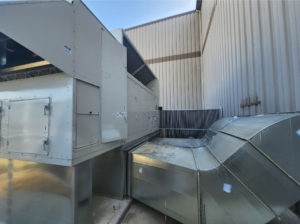
Restrictive duct geometry at the project site necessitated an innovative airflow measurement solution.
The end user faced the following challenges that necessitated an innovative airflow measurement solution:
- Compliance with OSHA regulations for room pressurization and ventilation during the transfer of medical-grade materials from shipping containers to storage. (Code requires the HVAC system to purge the loading docks with fresh air and vent system exhaust air to atmosphere.)
- Concerns regarding the accuracy of traditional AMD technology due to duct system geometry constraints.
- Incremental costs associated with installing and maintaining multiple AMDs for monitoring OA and EA flow rates.
Engagement and Expertise
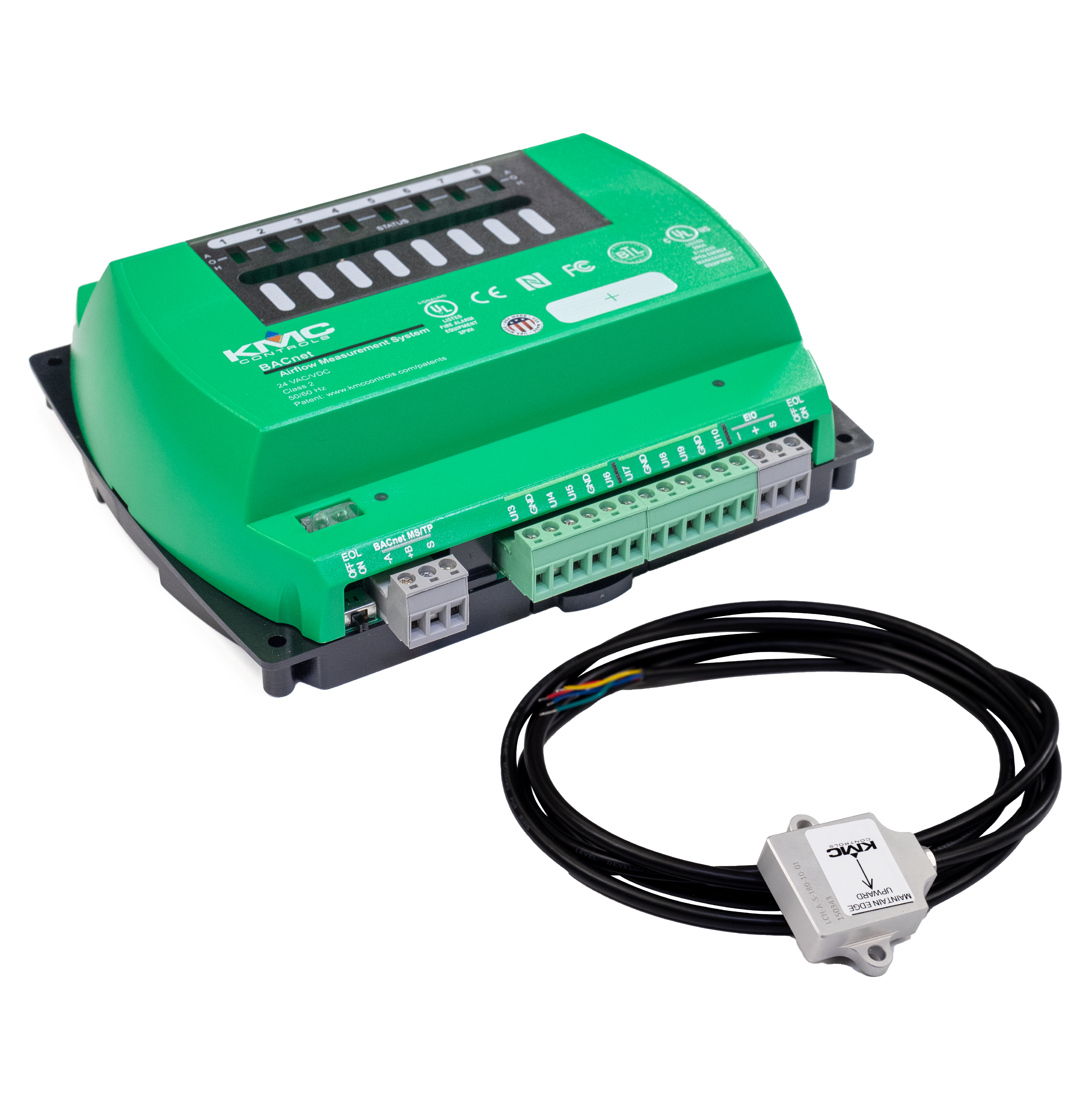
A BAC-5901C-AFMS (controller with inclinometer) is a core component of the AFMS.
ChampionAC engaged the end user on behalf of KMC Controls. The end user was convinced that KMC Control’s AFMS technology would offer more accurate, reliable, and sustainable airflow measurement readings than previously utilized traditional technologies.
The AFMS measures airflow rates using Characterized Airflow Performance® technology consistent with ASHRAE Standard 111 criteria. It produces reliable and repeatable measurements where traditional technology is known to be inaccurate—when duct geometry cannot afford 10 straight duct diameters upstream and three straight duct diameters downstream of the measurement location.
KMC Controls, a recognized expert in HVAC control and supervision, provided the necessary knowledge and solutions, which ChampionAC then implemented.
The Solution
To tackle the end user’s challenges, ChampionAC and KMC Controls implemented the following solution:
- ChampionAC presented the value statement of the AFMS to the end user and initiated collaboration with KMC Controls by providing engineering drawings for the project.
- KMC Controls provided consultation on AFMS sensor selection and installation locations.
- The Pressure Assist (PA) version of the AFMS was deployed due to the AHUs’ configuration, which featured a heat wheel with bypass damper, relief dampers, and an independently operated exhaust fan.
- The AFMS installation involved mounting an inclinometer to the outside air damper, airflow measurement probes on supply and exhaust fans, and installing new temperature sensors.
- The AFMS controller was set up in pass-through mode to control the outside air damper actuator and communicate with the factory-mounted BACnet controller via BACnet MS/TP (RS-485).
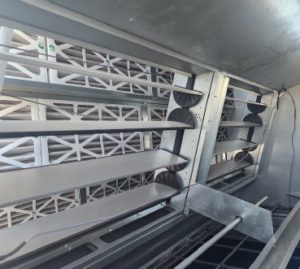
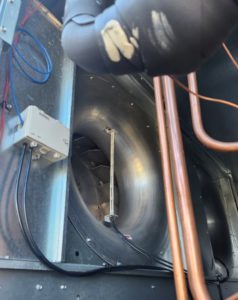
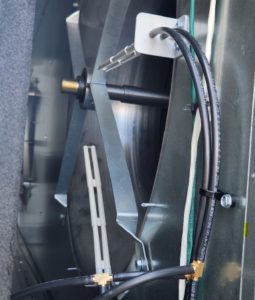
The KMC AFMS’s Characterized Airflow Performance® technology learns the unit’s airflow rates using data it collects from several sensors: an inclinometer (damper performance); flow measurement probes; and OAT, MAT, and RAT sensors.
Timeline
The implementation timeline for site preparation, design, installation, balancing, and commissioning of the five units amounted to approximately 50 labor hours.
Results
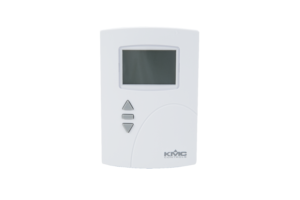
ACH (Air Changes per Hour) can be displayed from a wall-mounted NetSensor.
The solution provided by KMC Controls and ChampionAC yielded the following outcomes:
- Successful resolution of the end user’s challenges, with accurate measurement data for OA, RA (return air), supply fan, and exhaust fan airflow rates, ensuring balanced building pressurization.
- Quantification of leakage rates around the heat wheel, an unexpected benefit of the AFMS installation.
- Lower total cost compared to the previous project delivery method that required multiple AMDs and mechanical system modifications.
- ChampionAC gained valuable experience in installing the AFMS and balancing complex AHUs.
Long-Term Benefits
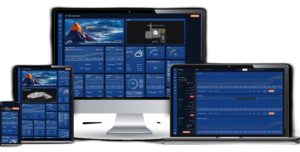
Using the AFMS measurements as a baseline, an IAQ (Indoor Air Quality) reporting dashboard could be established in the future.
The long-term benefits for the end user resulting from the AFMS implementation include:
- A reliable and sustainable airflow measurement solution, ensuring confidence in environmental quality and compliance with OSHA regulations.
- Performance data visibility through a wall-mounted NetSensor, including ACH (Air Changes per Hour) statistics.
- Embedded AFDD (Advanced Fault Detection and Diagnostics) offering ASHRAE Guideline 36 routines.
- Characterized Airflow Performance® calibration routine for monitoring accuracy drift and reducing maintenance and recalibration time.
- Ongoing monitoring of OA damper position feedback for trend analysis, enabling detection of damper blade deterioration or performance issues.
- Potential establishment of an IAQ (Indoor Air Quality) reporting dashboard using AFMS measurements as a baseline.
- Virtually zero maintenance for the life of the AFMS installation.
Conclusion
The successful implementation of the KMC AFMS by ChampionAC and KMC Controls resolved the end user’s pressurization and ventilation challenges effectively. Through accurate and reliable airflow measurement, the end user achieved compliance with OSHA regulations, reduced costs, and gained long-term monitoring capabilities. System integrators and facility managers in similar industries can rely on the proven capabilities of the AFMS to overcome their airflow measurement issues and ensure a sustainable, efficient, and healthy building environment.
For more information about the KMC Airflow Measurement System, please visit the AFMS landing page or contact the KMC Controls sales team.
The ChampionAC logo is the trademarks/service marks of its owner, who has not sponsored or approved any of this content.
 Cart
Cart
